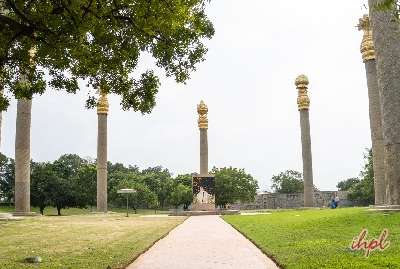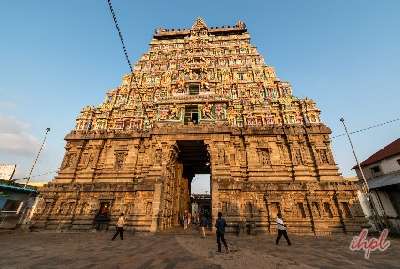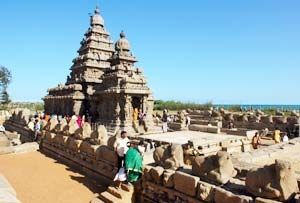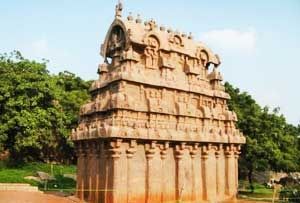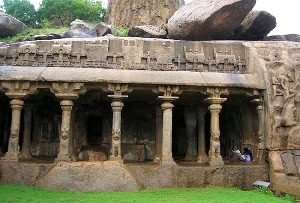The group of monuments at Mahabalipuram or Mamallapuram, were accorded the status of a UNESCO World Heritage Site in the year 1984. Consisting of approximately 40 sanctuaries, it also includes the largest open-air rock relief in the world.
These monuments are primarily divided into four categories, namely- Rathas, Mandapas or Cave Temples, Structural Temples and Rock Reliefs. The sea-port of this town is from where many Indian colonists sailed to South-East Asia during the time of Periplus. The ancient remnants of Mahabalipuram attract several tourists from across the world every day. Many of its structures date to the time of reign of the Pallavas (7th century) and the best of these were listed as UNESCO World Heritage Site under the name – Group of Monuments.
Explore 14 days South India temple tour package
Ratha Temples
Ratha Temples are chiseled to look like chariots. These temples are datable to the reign of Nahasimhavarman Mammalla (7th century) and are called the Pandava Rathas. There are mainly seven rathas, of which 5 are named after each of the Pandava brothers- Dharmraja Ratha, Arjuna Ratha, Bhima Ratha, Nakula Ratha and Sahadeva Ratha. The other two rathas are called Draupadi Ratha and Ganesha Ratha.
These chariots are carved out of a single rock but the construction was not completed, and this is the reason worship rituals are not performed here. The Arjuna Ratha, Draupadi Rathas, Dharmaraja Rathas and Draupadi Ratha have square plans, while Bhima Ratha and Ganesha Ratha have rectangular plans.
Check out Tamil Nadu tour packages, Kanchipuram tour packages, Rameswaram Tour Packages, Coonoor tour packages
Mandapas
Mandapas are eleven rock-cut cave temples covered with bas-relief, carved with the help of iron mallet and chisel. The most notable of these eleven cave temples are Varaha Cave Temple, Panchapandava Cave Temple, Krishna Cave Temple and Mahishasuramardini Mandava. According to the historians, these cave temples were cut and decorated with the help of panels in Mamalla style, sometime in 7th century.
There are other mandapas too which were built in the eighth century, like Adiranchanda Caves Temples. The remnants of these caves indicate they were painted and plastered. One of the most notable bas-reliefs is found inside the Mahsisuramardhini Cave Temple of Goddess Durga.
Krishna Cave Temple exhibits the sculptural representation of Lord Krishna holding the Govardhana Hill in order to protect cow herds and gopis from floods and heavy rain, along with other such sculptures. Varaha Cave Temple’s most admired sculpture is the one that depicts the incarnation of Lord Vishnu lifting Earth above the sea. Similarly, Mahishasuramardini Mandapa and other cave temples contain interesting architectural features.
Check out Tamil Nadu temple tour packages, Ooty tour packages, Mahabalipuram tour packages, Coimbatore tour packages
Rock Relief
The Rock Reliefs of Mahabalipuram are carved either on independent boulders or rocks. These are popular mainly because of the exquisite bas-relief work, especially Descent of the Ganges (also called Bhagiratha’s Penance and Arjuna’s Penance) which also are the open-air relief and world’s largest bas-relief work. This bas-relief was sculpted on two huge granite boulders, with length – 27m and height – 9 m. The sculpture represents different mythological episodes of Hindu religious belief. The Hindu has regarded this as “one of the marvels of the sculptural art of India”.
Structural Temple
One of Mahabalipuram’s most famous attractions is the Shore Temple Complex. The temple is named so as it is located on a seashore. This temple consists of three temples, among which two are small and one large. The main temple is 6ft high and is decorated with sculptures and images of Lord Krishna. The other two temples of the complex are known as Nripatsimha Pallava Vishnugriha and Rajasimhesvara.



